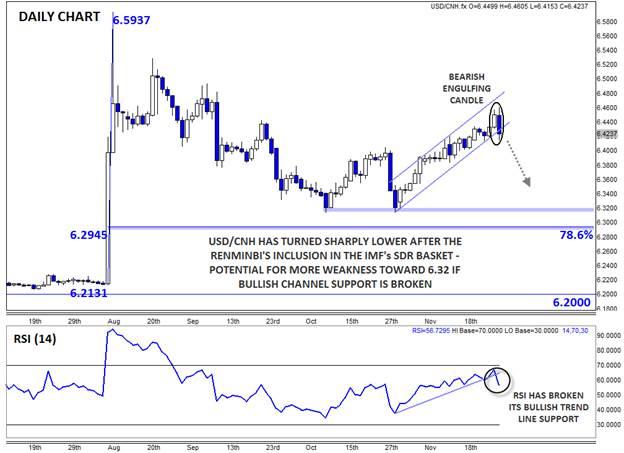![]()
In a week full of market-moving three-letter acronyms (ECB, NFP RBA, PMI, and GDP from Australia and Canada), many traders may not be intimately familiar with the three-letter acronym that’s grabbing all the headlines today.
The International Monetary Fund (IMF) maintains a stockpile of foreign exchange reserve assets called Special Drawing Rights (SDR). In essence, SDRs represent a basket of other widely-used currencies that was created back in the late ‘60s to supplement a shortfall of US dollars and gold. Every five years, the IMF reviews the currencies and weights within the SDR basket to ensure that it still reflects the importance and usage of global currencies.
As it happens, the IMF completed its semi-decadal review earlier today, and as widely expected, opted to include the Chinese renminbi in its SDR basket effective October 1, 2016. Though it was generally expected, the IMF’s inclusion of the RMB within the SDR basket represents a major triumph for Chinese authorities, who have been liberalizing trade in the renminbi for years in an attempt to increase the international clout of the currency.
The previous and new SDR basket weights can be seen below:
· 2011-2016: US dollar (41.9%), euro (37.4%), pound (11.3%), yen (9.4%)
· Starting October 2016: US dollar (41.7%), euro (30.9%), Chinese yuan (10.9%), yen (8.3%), pound (8.1%)
As you can see, the biggest loser from this change was the euro, while the yen and the pound also saw their significance decrease. The dollar’s weight will be essentially unchanged after this update goes into effect.
By now, many readers are no doubt wondering what this means for markets. First of all, it’s worth noting that although many analysts refer to SDRs as “reserves,” this shift does not mean that China’s currency has become a “reserve currency” in the traditional sense of the word. The dollar is and will be the world’s reserve currency for the foreseeable future.
That said, there are nearly $300B in SDRs in circulation that will have to be adjusted for the new distribution over the next ten months. A portion of this massive stockpile of reserves will have to be rebalanced away into Chinese yuan and away from (primarily) the euro. This colossal wave of capital flowing into China’s currency should provide support the CNY and CNH while providing traders with yet another reason to sell the beleaguered euro.
Technical view: USD/CNH
Looking at the recently-liberalized USD/CNH exchange rate shows that bears are having a strong day. The pair is currently carving out a big Bearish Engulfing Candle* on the daily chart, signaling a strong shift from buying to selling pressure. Meanwhile, the pair is on the verge of breaking down from its 1-month bullish channel, a move that the RSI indicator has already foreshadowed.
The full brunt of the IMF’s decision will play out over the next ten months and many other factors will no doubt influence the yuan’s value over that period, but in the short-term, a confirmed break below the bullish channel could open the door for a deeper retracement in USD/CNH toward its recent lows its recent lows in the 6.32 zone.
*A Bearish Engulfing candle is formed when the candle breaks above the high of the previous time period before sellers step in and push rates down to close below the low of the previous time period. It indicates that the sellers have wrested control of the market from the buyers.

This research is for informational purposes and should not be construed as personal advice. Trading any financial market involves risk. Trading on leverage involves risk of losses greater than deposits.
Recommended Content
Editors’ Picks

AUD/USD: The hunt for the 0.7000 hurdle
AUD/USD quickly left behind Wednesday’s strong pullback and rose markedly past the 0.6900 barrier on Thursday, boosted by news of fresh stimulus in China as well as renewed weakness in the US Dollar.

EUR/USD refocuses its attention to 1.1200 and above
Rising appetite for the risk-associated assets, the offered stance in the Greenback and Chinese stimulus all contributed to the resurgence of the upside momentum in EUR/USD, which managed to retest the 1.1190 zone on Thursday.

Gold holding at higher ground at around $2,670
Gold breaks to new high of $2,673 on Thursday. Falling interest rates globally, intensifying geopolitical conflicts and heightened Fed easing bets are the main factors.

Bitcoin displays bullish signals amid supportive macroeconomic developments and growing institutional demand
Bitcoin (BTC) trades slightly up, around $64,000 on Thursday, following a rejection from the upper consolidation level of $64,700 the previous day. BTC’s price has been consolidating between $62,000 and $64,700 for the past week.

RBA widely expected to keep key interest rate unchanged amid persisting price pressures
The Reserve Bank of Australia is likely to continue bucking the trend adopted by major central banks of the dovish policy pivot, opting to maintain the policy for the seventh consecutive meeting on Tuesday.

Five best Forex brokers in 2024
VERIFIED Choosing the best Forex broker in 2024 requires careful consideration of certain essential factors. With the wide array of options available, it is crucial to find a broker that aligns with your trading style, experience level, and financial goals.